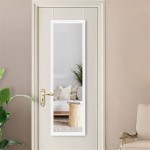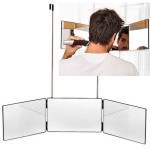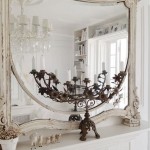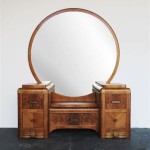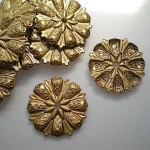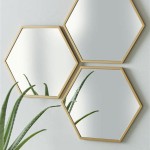Antique Vanity Set With Mirror
Antique vanity sets with mirrors offer a glimpse into the past, reflecting bygone eras of elegance and craftsmanship. More than just functional furniture, these pieces serve as decorative focal points, adding a touch of vintage charm to bedrooms and dressing areas. This article explores the various aspects of antique vanity sets, from their historical significance to practical considerations for collectors and enthusiasts.
Key Features of Antique Vanity Sets
Antique vanity sets typically comprise a table or desk, a mirror, and a chair or stool. The table often includes drawers and compartments for storing cosmetics and personal items. Mirrors can be single, triptych (three-paneled), or even larger, depending on the style and period. Many sets also incorporate decorative elements such as intricate carvings, inlaid designs, or painted motifs.
Historical Context and Evolution
The concept of the vanity table dates back centuries. Early examples were simple dressing tables used for basic grooming. During the 18th and 19th centuries, vanities evolved into more elaborate pieces, reflecting the growing emphasis on personal appearance and fashion. The Victorian era saw the rise of ornate vanities, often featuring intricate carvings and luxurious materials like mahogany and rosewood. The Art Deco period of the 1920s and 30s introduced geometric designs and streamlined silhouettes, while the mid-20th century embraced simpler, more functional styles.
Popular Styles and Periods
Several distinct styles characterize antique vanity sets, each reflecting the aesthetic trends of its time. Victorian vanities are known for their ornate details and dark wood finishes, often incorporating marble tops and intricate carvings. Art Deco vanities showcase geometric shapes, sleek lines, and materials like chrome and Bakelite. French Provincial vanities offer a romantic, feminine aesthetic, typically featuring curved lines, delicate carvings, and light-colored wood finishes.
Materials and Construction
Antique vanity sets were crafted from a variety of materials, reflecting both the stylistic preferences and available resources of the period. Common woods include mahogany, walnut, oak, maple, and rosewood. High-end vanities might incorporate more exotic woods like ebony or satinwood. Other materials include marble for tabletops, glass for mirrors, and various metals for hardware and decorative accents.
Identifying Authentic Antique Vanities
Identifying an authentic antique vanity requires careful examination and attention to detail. Look for signs of age and wear, such as patina on the wood, minor imperfections in the finish, and evidence of hand-craftsmanship. Examine the construction techniques, joinery, and hardware. Researching specific styles and periods can further assist in authentication. Consulting with a reputable antiques dealer or appraiser is recommended for valuable pieces.
Restoration and Care
Proper care and maintenance are essential for preserving the beauty and value of antique vanity sets. Regular dusting with a soft cloth is crucial. Avoid harsh chemicals and abrasive cleaners, which can damage the finish. For deeper cleaning, consult a professional furniture restorer. Address any structural damage or loose joints promptly to prevent further deterioration. Store the vanity in a stable environment, away from extreme temperatures and humidity fluctuations.
Collecting and Investing in Antique Vanities
Collecting antique vanities can be a rewarding pursuit, both aesthetically and potentially financially. Researching different styles, periods, and makers is essential for making informed purchasing decisions. Condition plays a significant role in determining value, as does the rarity and provenance of a piece. Consulting auction catalogs, antique guides, and reputable dealers can provide valuable insights into the market and potential investment value.
Incorporating Antique Vanities into Modern Decor
Antique vanities can seamlessly integrate into a variety of interior design styles. In a traditional setting, they complement period furniture and décor. In a more contemporary space, an antique vanity can serve as a striking focal point, adding a touch of vintage charm and character. Consider the size and scale of the vanity in relation to the room's proportions. Balance the antique piece with other furnishings and decorative elements to create a cohesive and visually appealing space.
Practical Considerations for Using Antique Vanities
While antique vanities offer aesthetic appeal, there are practical considerations for their use in a modern setting. Assess the functionality of the drawers and storage compartments. The height and dimensions of the table and mirror should be comfortable for daily use. If the original mirror is damaged or unsuitable, consider having it professionally replaced while preserving the vanity's overall aesthetic. Evaluate the stability and condition of the chair or stool accompanying the set. Re-upholstering or repairing the chair may be necessary to ensure comfort and functionality.

Sold Out Example Of My Work Antique Dressing Table With

Antique Makeup Vanity Dresser Mirror

Sold 1920s Antique Vanity With Mirror And Stool Dressing

Handcrafted Vintage Dresser With Seat And Mirror French

Handcrafted Vintage Dresser With Seat And Mirror French

Vintage Vanity Style Pender Peony A Southern Blog

Sold 1920s Antique Vanity With Mirror And Stool Dressing

Sold 1920s Antique Vanity With Mirror And Stool Dressing

Antique Vanity With Mirror Chair And Nightstand Makeover

Antique Vanity With Mirror Vintage Dressing Table Black Floral Woman S Makeup Station Writing Desk Yahoo Ping


